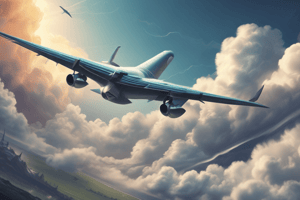Podcast
Questions and Answers
What is the primary classification criterion for fronts?
What is the primary classification criterion for fronts?
- Temperature of air masses (correct)
- Humidity levels
- Wind direction
- Air pressure
What is the typical weather associated with a warm front?
What is the typical weather associated with a warm front?
- Thunderstorms and heavy rain
- Snow and freezing temperatures
- Light rain, drizzle, and clouds (correct)
- Clear skies and fair weather
What happens when a cold front overtakes a warm front?
What happens when a cold front overtakes a warm front?
- An occluded front is formed (correct)
- A stationary front forms
- A warm front strengthens
- A cold front weakens
What is a significant concern for flight safety near a warm front?
What is a significant concern for flight safety near a warm front?
What is the characteristic of a stationary front?
What is the characteristic of a stationary front?
What can cause rapid changes in wind direction and speed, temperature, and visibility?
What can cause rapid changes in wind direction and speed, temperature, and visibility?
What is essential for pilots to anticipate the weather they will encounter?
What is essential for pilots to anticipate the weather they will encounter?
What can be associated with a cold front?
What can be associated with a cold front?
What is the typical weather pattern near a stationary front?
What is the typical weather pattern near a stationary front?
What can be challenging for aviators to predict and prepare for?
What can be challenging for aviators to predict and prepare for?
A stationary front is formed when a cold front overtakes a warm front.
A stationary front is formed when a cold front overtakes a warm front.
Warm fronts are always associated with severe weather phenomena like thunderstorms and heavy rain.
Warm fronts are always associated with severe weather phenomena like thunderstorms and heavy rain.
A cold front can bring clear skies and no precipitation.
A cold front can bring clear skies and no precipitation.
Occluded fronts are always characterized by clear skies and good visibility.
Occluded fronts are always characterized by clear skies and good visibility.
Fronts can cause changes in wind direction only.
Fronts can cause changes in wind direction only.
Understanding the position and movement of fronts is not essential for pilots.
Understanding the position and movement of fronts is not essential for pilots.
Cold fronts always move rapidly.
Cold fronts always move rapidly.
There are only three main types of fronts.
There are only three main types of fronts.
Warm air masses always move faster than cold air masses.
Warm air masses always move faster than cold air masses.
Icing conditions are never associated with cold fronts.
Icing conditions are never associated with cold fronts.
What type of front is formed when a colder air mass displaces a warmer air mass, leading to severe weather phenomena?
What type of front is formed when a colder air mass displaces a warmer air mass, leading to severe weather phenomena?
How does the air ahead of a warm front change as the front moves?
How does the air ahead of a warm front change as the front moves?
What happens when two air masses are unable to displace each other, leading to a standstill?
What happens when two air masses are unable to displace each other, leading to a standstill?
What is the result of a cold front overtaking a warm front?
What is the result of a cold front overtaking a warm front?
Why is it essential for pilots to understand the position and movement of fronts?
Why is it essential for pilots to understand the position and movement of fronts?
What can be a significant concern for flight safety near a warm front?
What can be a significant concern for flight safety near a warm front?
How does the movement of a cold front affect temperature?
How does the movement of a cold front affect temperature?
What is a characteristic of an occluded front?
What is a characteristic of an occluded front?
Why do pilots need to plan carefully around cold fronts?
Why do pilots need to plan carefully around cold fronts?
What is a key factor in predicting weather patterns for aviators?
What is a key factor in predicting weather patterns for aviators?
Study Notes
Air Masses
- Air masses are large bodies of air with uniform temperature, humidity, and pressure, dominating large regions and greatly influencing weather conditions.
- Two primary classification criteria for air masses: their source region and their underlying surface.
- Maritime air masses:
- Originate over vast water bodies
- Inherently moist
- Can be cool (e.g., from the North Atlantic) or warm (e.g., from the tropical Pacific)
- Continental air masses:
- Form over land
- Tend to be drier
- Exhibit temperature characteristics of their birthplace (e.g., cooler in the arctic regions and warmer in the subtropics or tropics)
- Tropical air masses:
- Born in the equatorial zones
- Imbued with warmth
- Polar air masses:
- Arise in the higher latitudes
- Bring colder temperatures when they migrate southward or northward, subject to the hemisphere
Effects of Air Masses on Aviation
- Temperature and humidity differences affect an aircraft's engine efficiency and visibility conditions due to fog or cloud formation.
- Interactions between air masses lead to the development of weather fronts, which can spawn various weather phenomena from clear skies to violent thunderstorms.
- Recognizing air masses' unique thermal and moisture profiles allows pilots to predict fog, icing conditions, turbulence, and understand the genesis of storm systems.
Weather Fronts
- A weather front is a boundary separating two masses of air of different densities and typically with different temperatures.
- Four main types of fronts:
- Cold front:
- Identified by a blue line and triangles pointing in the direction of travel
- Cold air pushes underneath the warmer air, forcing it up rapidly
- Leads to tall cloud formations, often culminating in thunderstorms or heavy rain
- Warm front:
- Symbolized by a red line with semi-circles
- Warm air advances, gliding above the cooler, denser air
- Creates a gradual climb, often resulting in steady precipitation and stratus cloud formations
- Stationary front:
- Represented by alternating blue triangles and red semi-circles
- Occurs when both cold and warm air masses are at a standoff
- Results in cloudy, wet weather that could linger for days
- Occluded front:
- Involves a mix of both warm and cool air characteristics
- A cold front has caught up with a warm front
- Often leads to a wide variety of weather patterns
- Cold front:
Importance of Understanding Weather Fronts for Aviation
- Understanding weather fronts is crucial for safe flying, as they can cause rapid changes in wind direction and speed, temperature, and visibility.
- Pilots must be able to identify and respond to fronts to anticipate changes in flight conditions and make informed decisions.
Air Masses
- Air masses are large bodies of air with uniform temperature, humidity, and pressure, dominating large regions and greatly influencing weather conditions.
- Two primary classification criteria for air masses: their source region and their underlying surface.
- Maritime air masses:
- Originate over vast water bodies
- Inherently moist
- Can be cool (e.g., from the North Atlantic) or warm (e.g., from the tropical Pacific)
- Continental air masses:
- Form over land
- Tend to be drier
- Exhibit temperature characteristics of their birthplace (e.g., cooler in the arctic regions and warmer in the subtropics or tropics)
- Tropical air masses:
- Born in the equatorial zones
- Imbued with warmth
- Polar air masses:
- Arise in the higher latitudes
- Bring colder temperatures when they migrate southward or northward, subject to the hemisphere
Effects of Air Masses on Aviation
- Temperature and humidity differences affect an aircraft's engine efficiency and visibility conditions due to fog or cloud formation.
- Interactions between air masses lead to the development of weather fronts, which can spawn various weather phenomena from clear skies to violent thunderstorms.
- Recognizing air masses' unique thermal and moisture profiles allows pilots to predict fog, icing conditions, turbulence, and understand the genesis of storm systems.
Weather Fronts
- A weather front is a boundary separating two masses of air of different densities and typically with different temperatures.
- Four main types of fronts:
- Cold front:
- Identified by a blue line and triangles pointing in the direction of travel
- Cold air pushes underneath the warmer air, forcing it up rapidly
- Leads to tall cloud formations, often culminating in thunderstorms or heavy rain
- Warm front:
- Symbolized by a red line with semi-circles
- Warm air advances, gliding above the cooler, denser air
- Creates a gradual climb, often resulting in steady precipitation and stratus cloud formations
- Stationary front:
- Represented by alternating blue triangles and red semi-circles
- Occurs when both cold and warm air masses are at a standoff
- Results in cloudy, wet weather that could linger for days
- Occluded front:
- Involves a mix of both warm and cool air characteristics
- A cold front has caught up with a warm front
- Often leads to a wide variety of weather patterns
- Cold front:
Importance of Understanding Weather Fronts for Aviation
- Understanding weather fronts is crucial for safe flying, as they can cause rapid changes in wind direction and speed, temperature, and visibility.
- Pilots must be able to identify and respond to fronts to anticipate changes in flight conditions and make informed decisions.
Air Masses
- Air masses are large bodies of air with uniform temperature, humidity, and pressure, dominating large regions and greatly influencing weather conditions.
- Two primary classification criteria for air masses: their source region and their underlying surface.
- Maritime air masses:
- Originate over vast water bodies
- Inherently moist
- Can be cool (e.g., from the North Atlantic) or warm (e.g., from the tropical Pacific)
- Continental air masses:
- Form over land
- Tend to be drier
- Exhibit temperature characteristics of their birthplace (e.g., cooler in the arctic regions and warmer in the subtropics or tropics)
- Tropical air masses:
- Born in the equatorial zones
- Imbued with warmth
- Polar air masses:
- Arise in the higher latitudes
- Bring colder temperatures when they migrate southward or northward, subject to the hemisphere
Effects of Air Masses on Aviation
- Temperature and humidity differences affect an aircraft's engine efficiency and visibility conditions due to fog or cloud formation.
- Interactions between air masses lead to the development of weather fronts, which can spawn various weather phenomena from clear skies to violent thunderstorms.
- Recognizing air masses' unique thermal and moisture profiles allows pilots to predict fog, icing conditions, turbulence, and understand the genesis of storm systems.
Weather Fronts
- A weather front is a boundary separating two masses of air of different densities and typically with different temperatures.
- Four main types of fronts:
- Cold front:
- Identified by a blue line and triangles pointing in the direction of travel
- Cold air pushes underneath the warmer air, forcing it up rapidly
- Leads to tall cloud formations, often culminating in thunderstorms or heavy rain
- Warm front:
- Symbolized by a red line with semi-circles
- Warm air advances, gliding above the cooler, denser air
- Creates a gradual climb, often resulting in steady precipitation and stratus cloud formations
- Stationary front:
- Represented by alternating blue triangles and red semi-circles
- Occurs when both cold and warm air masses are at a standoff
- Results in cloudy, wet weather that could linger for days
- Occluded front:
- Involves a mix of both warm and cool air characteristics
- A cold front has caught up with a warm front
- Often leads to a wide variety of weather patterns
- Cold front:
Importance of Understanding Weather Fronts for Aviation
- Understanding weather fronts is crucial for safe flying, as they can cause rapid changes in wind direction and speed, temperature, and visibility.
- Pilots must be able to identify and respond to fronts to anticipate changes in flight conditions and make informed decisions.
Studying That Suits You
Use AI to generate personalized quizzes and flashcards to suit your learning preferences.
Related Documents
Description
Learn about the characteristics of air masses, a crucial element in understanding and anticipating weather patterns for safe flying. Grasp these meteorological concepts for your aviation journey.




